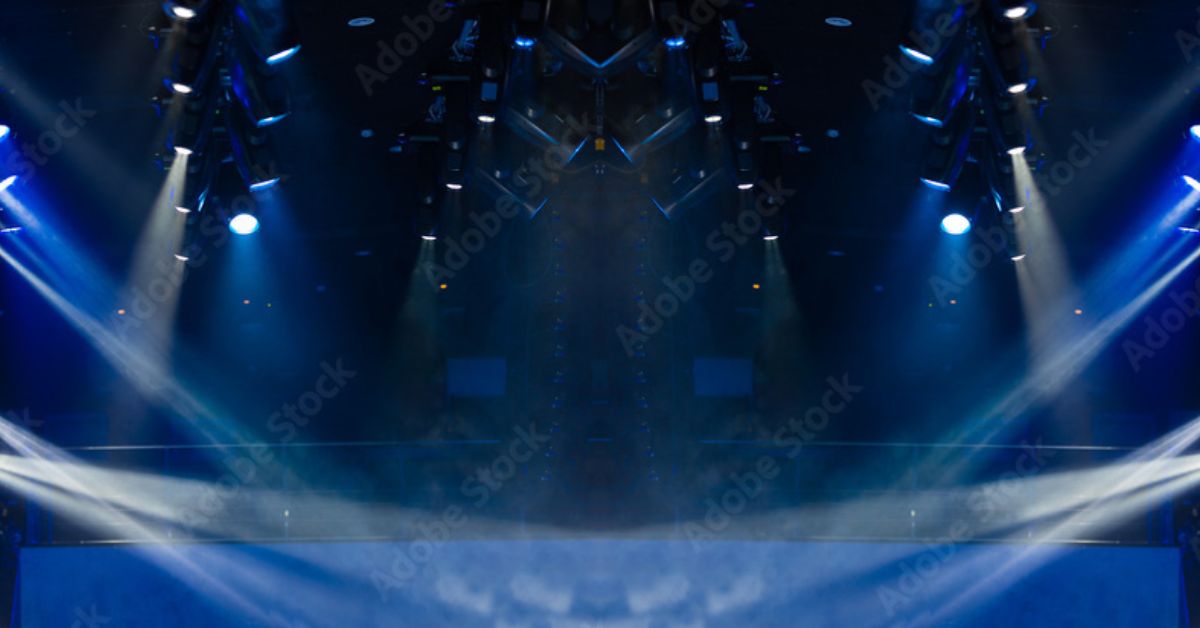Stage lighting constitutes the unseen power that converts ordinary theatre activity into an alluring show. The wordless narrator communicates through a sense of mood, a feeling of atmosphere, and an underlining emotional statement.
Lighting design is more than simply lighting the stage; it involves engaging the audience’s eyes, ears, emotions, and feelings, creating performance in a way that words cannot adequately depict.
Moreover, there is audio visual communication that plays a pivotal role in modern presentations, seamlessly integrating sound and visual elements to convey information effectively.
Here, you can engage in stage lighting with a special focus on creating effective lighting plots that can move any audience.
The Power of Lighting in Performance
Setting the Scene
Think of an empty room with one light shining on a single character. It is a sad, reflective, and introspective mood. Imagine a colorful explosion of lights in tune with exciting beats now. Within seconds, the mood transforms into colorful, thrilling, and festive.
The magic of stage lighting basics lies in its capacity to generate different worlds, arouse emotions, and take the audience into the core of the spectacle.
Enhancing Visual Appeal
Visual composition through lighting on stage. The spotlight can bring out the center of focus, colorful costumes, and stage props and direct the viewers to follow the act. The right stage light names can create a soft or diffuse glow for romance or sharp contrast for drama to make the performance more appealing to look at.
Amplifying Emotions
The colors, intensity, and movement of light can enhance the effects of an event. Warm colors like reds and colors stir up intense feelings of passion, and others make people feel calm or sad. Variations of light’s intensity and patterns imitate the mood of a plot developing, causing excitement, happiness, or even sorrow from spectators.
Elements of Effective Stage Lighting Design
Understanding the Basics
Understanding the fundamental elements is crucial before diving into the intricacies of lighting design. These include:
- Intensity: Intensity refers to the brightness or dimness of the light source. It’s a crucial element in setting a performance’s overall mood and atmosphere. Light intensity can be controlled using dimmers or by adjusting the output of the lighting fixture itself.
- Color: Color in lighting design is about the hue and temperature of light, which can profoundly impact a performance’s visual and emotional aspects. Color filters or gels are often used to modify the color of the light emitted by fixtures.
- Direction: The direction of stage lighting basics plays a crucial role in creating shadows, emphasizing certain elements, and providing depth to the stage. By altering the angle and orientation of the light source, lighting designers can manipulate the way objects, actors, and scenes are perceived.
- Movement: Movement refers to altering the position or pattern of light during a performance. Dynamic lighting changes can enhance the dramatic impact of a scene, create transitions between different moments, or guide the audience’s focus.
- Texture: Texture in lighting involves using various tools and techniques to create patterns, textures, or visual effects with light. This might include employing accessories like gobos (patterned templates) to project-specific shapes or designs onto the stage or using textured filters to alter the quality of light.
Collaboration and Planning
Theater lighting design is a shared responsibility of the director, designer, and technician. This encompasses carefully considering the script, set design, intended moods, and overall style in which the play is envisioned. Effective communication within the team creates a unified approach toward improving production, which generates groundbreaking ideas.
Creating a Lighting Plot
The lighting plot resembles a plan for the stage lighting design. It specifies the locations of light fixtures, coloring, cues, and timing during the show. A lighting plot allows for proper rehearsal of every lighting change and its purpose, resulting in a smooth run during rehearsals and live performances.
Equipment and Technology
Stage lighting has benefited from technological advances in light systems. Designers are equipped with various tools such as LED lights, moving heads, intelligent lighting fixtures, and programmable consoles, which they can incorporate into their artistic works in order to develop sophisticated and interesting lighting compositions. Today’s architectural lighting designer needs to be knowledgeable about such tools and abreast of developments.
8 Major Types of Stage Lights
Floodlights
Regarding types of lighting in theatre, wash lights or floodlights are designed to bathe the entire stage with uniform illumination. These lights help in creating soft lighting to create an overall mood/ambiance of the scene. These come in various sizes, adjustable for any intensity or color desired.
Spotlights
These are intensive and narrow beams of lighting directed at a particular performer, prop, or segment of the staging ground for emphasis. The concentrated light beam enables their accurate focus on specific areas for attention by the audience. Spotlights are indispensable when one is highlighting important moments or personalities of a play.
Fresnel Lights
When it comes to types of lighting in theatre, the lighted lamp has a stepped optical element whose lens is adjustable, leading to a change in beam direction and suitability. With ease of control, they form soft-edged beams mostly employed for general wash and a particular area of focus on stage.
PAR Cans (Parabolic Aluminized Reflector)
PAR cans or PARs (robust and durable type lights generating a powerful beam of light). These types of stage lights come in different sizes and provide laser-like effects that draw attention to details or brightly colored backwashes. Due to their flexibility and robustness, PAR cans often find application in various concert and event settings.
ERS, also known as LLeko Spot
These types of theatre lights are called ERS Lekos and have bright, focused beams that shutters and gobo patterns can shape. These lights are usually employed to emphasize performers or objects in a defined manner and provide distinct borders and clear lighting for scenes.
Moving Head Lights
They consist of various moving headlights that scan, zoom in and out, and shift colors or patterns dynamically. The designers can use various movements and effects to craft dramatic and interactive lighting sequences. They are also easily adjustable, thus suitable for bringing drama and fluidity to the stage.
LED Lights
Regarding theater lighting design, LED lights are popularly used on stages because of their longevity and ability to perform complex tasks. These include wash lights, PAR cans, and movers, among others. The use of LED technology provides multicolor choices, enhanced precision, and energy-efficient techniques.
Strip Lights and Cyc Lights
These include strip lights and cyc lights, which, when used together, illuminate large surfaces like backdrops or “cycloramas” (cycs). With their full wash of light covering the background, these lights allow them to change into various colors, creating an ambiance and mood for the different scenes.
Every type and stage lighting example serves a distinct purpose, and skilled lighting designers combine these lights to create intricate, engaging, and visually captivating experiences that enhance the storytelling aspect of theatrical performances and events.
Techniques for Impactful Lighting Design
Layering Lights
As we are talking about the stage lighting basics, layering involves using multiple light sources to create depth and dimension on stage. By combining key, fill, and backlighting, designers can sculpt the space, emphasize characters, and add texture to scenes, resulting in a visually rich and engaging experience for the audience.
Utilizing Color Psychology
Knowing how colors affect people psychologically aids in evoking the right feelings. Warm colors like reds, oranges, and yellows convey energy, passion, and intimacy, while cooler tones like blues and greens evoke calmness, melancholy, or mystery. Skillful use of color can evoke powerful emotional responses from the audience.
Dynamic Light Changes
Concerning stage lighting examples, seamless transitions and dynamic changes in lighting add dynamism to a performance. Slow fades, sudden bursts, or rapid color shifts can accentuate pivotal moments, create tension, or signify shifts in time or mood. When well-timed and executed, these changes intensify the audience’s engagement with the performance.
Movement and Effects
Integrating moving lights and effects such as gobos (light patterns) or projections can transform a static scene into a visually immersive experience. Moving stage light names add fluidity and dynamism, while effects can create illusions, transport the audience to different settings, or evoke specific atmospheres, enriching the storytelling aspect of the performance.
The Bottom Line Is
Stage lighting is an art form that transcends mere illumination. It is the silent partner of actors, directors, and set designers, pivotal in creating memorable performances. Its ability to evoke emotions, sculpt visual landscapes, and guide the audience’s emotions makes it an indispensable element of theatrical productions.
Crafting impactful lighting designs requires creativity, technical expertise, and a deep understanding of storytelling. It’s about painting with light, using it to shape narratives, and leaving a lasting impression on audiences long after the curtains close.
By mastering the art of stage lighting, designers can transform ordinary performances into extraordinary experiences, leaving audiences spellbound and enchanted.
Furthermore, most people prefer light rentals for events for their functions tailored to elevate the ambiance and create unforgettable experiences.
As with any art form, mastery comes with practice, experimentation, and an unwavering passion for the craft. So, let the stage be your canvas, and let light be your brush, painting captivating tales that captivate, inspire, and leave audiences in awe.

